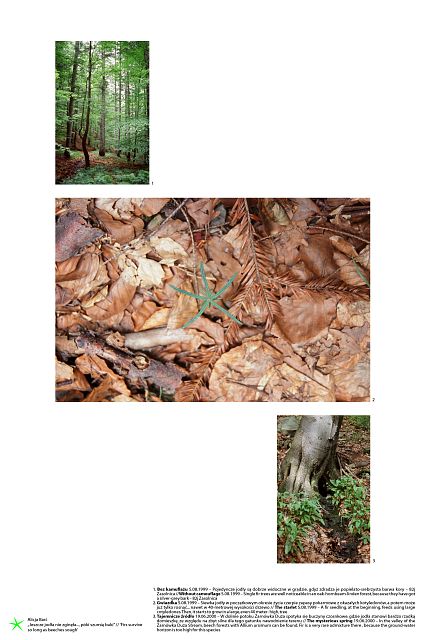 |
'Firs survive so long as beeches sough'
'Distribution, quantitative participation and vitality of silver fir Abies alba MILL. in forest communities of the Beskid Mały' ALICJA BARĆ
University of Silesia, Faculty of Biology and Environmental Protection,
Department of Geobotany and Nature Protection; Jagiellońska28, 40-032 Katowice
e-mail: abarc@us.edu.pl |

Description popularizing the research project
Venerable oaks of Białowieża Forest are 650 years old. In comparison to them only 150-year-old tree stands in Beskid Mały Range do not seem to matter too much. Nevertheless even the depleted remnants the ancient Carpathian Forest are a precious treasure of Silesia. In Katowice there was almost no trace left of the primeval forest 150 years ago i.e. the period when the first records mention forests in Beskid. Our ancestors cut down what was left of the forest to make room for steelworks, coal mines, factories, breweries, bakeries and dumps. According to Austrian charts when Beskid Mały Range was covered with beech and fir forests in Katowice itself there were already 15 coal mines, 15 steelworks and 2 factories. History let the environment in Beskidy survive and regenerate.
Six generations ago there were almost no forest in the Silesian landscape. A fir tree requires two generations to reach the canopy of the forest starting from a tiny seedling wrapped in a blanket of beech leaves. It needs two generations and a lot of peace. Without intensive felling, exploitation of resources and industrial emissions a forest filled with hidden treasures grows. In humid twilight of dark corners of the forest, far from touristic trails, rare flowers bloom as they find conditions suitable for them only in such places where deeply rooted in the rocky ground mighty trees prepare soil for picky plants.
Not only minerals are the treasure of Upper Silesia. When they are gone, when the economic situation changes and they heavy industry goes out of date these are the beech an fir forests in Beskidy that are much more precious. In future these forests will matter more than falling down branches of industry.
Abstract
During studies conducted in the Beskid Mały, in years 1996-2002, the oldest tree stands with participation of silver fir were searched. These are remnants of the Carpathian Primeval Forest, which are characteristic for this area. The oldest tree stand of this type was 146 years old (according to the forest management plans), while the youngest one selected for the studies, was approximately 80 years old.
It has been proved where and in which way the oldest tree stands with more than 30 per cent of fir participation in the canopy were distributed. Moreover, their phytosociological differentiation has been presented. Then, fir vitality has been assessed in 68 forest sections, making a study net. In fir, beech and sycamore old-stands the exclusive for the Beskid Mały localities of rare (Vicia dumetorum) and protected vascular plants (Arum alpinum, Cephalanthera longifolia) were found. It confirms the hypothesis that, so called "old tree stands" gather the biological diversity of an area and preserve its natural value.
Results of the studies were very interesting. New questions and scientific problems arise. The photographic documentation presented here is a measurable, but incidental effect of the studies. However, it focuses on a variety of biological phenomena, richness of life and death forms. Many of them can be observed in one, chosen forest section; others can be seen only in the middle of the Beskidian wilderness.

